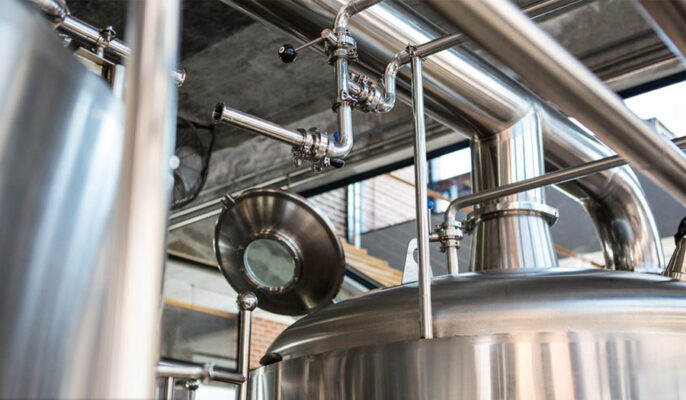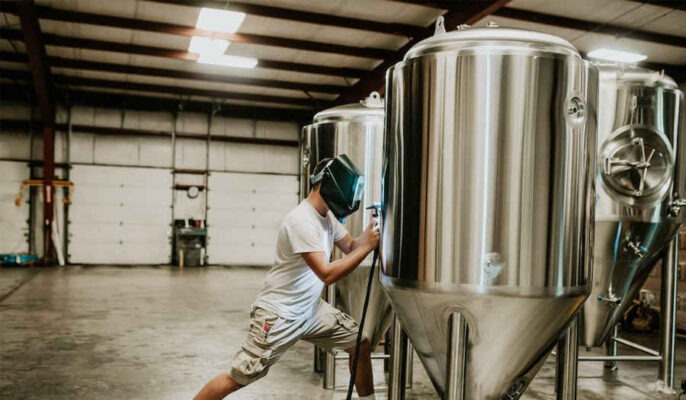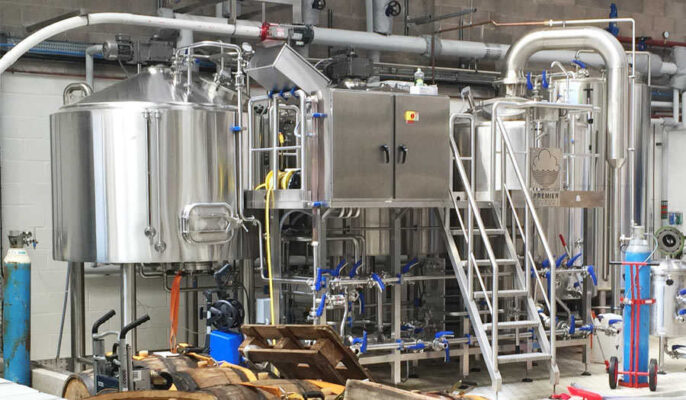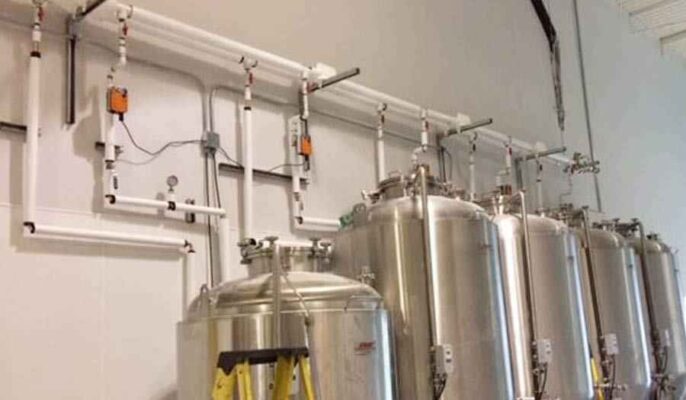Homebrewing and craft beer have exploded in popularity in recent years. More and more people are getting into brewing their own beer at home or starting their own microbreweries. However, large-scale commercial brewing equipment can be prohibitively expensive for small producers.
This guide will provide a comprehensive overview of small beer brewing equipment suitable for homebrewers and microbrewery startups. We will cover the key equipment needed, types, characteristics, applications, specifications, sizing, pricing, installation, operation, maintenance, and suppliers.
Overview of Small Beer Brewing Equipment
Small beer brewing equipment allows crafting high quality beer on a budget by scaling down commercial brewery equipment to smaller batches. The basic brewing process and main components remain the same. The equipment is made from stainless steel to maintain food-grade hygiene and adapted for small spaces.
The key equipment components in small beer brewing are:
- Mash tun – Mixes crushed malt with hot water to extract sugars
- Lauter tun – Separates sweet wort from spent grains
- Brew kettle – Boils wort and hops together
- Fermenter – Ferments sweet wort into beer
- Kegging system – Transfers and stores finished beer
Additional equipment like pumps, valves, chillers, filters, etc. automate the process. Scale, simplicity, compact footprint and affordable prices distinguish small brewing equipment. Let’s look at each system component in detail.
Types of Small Beer Brewing Equipment
There are a few configurations of small brewing equipment based on production goals:
| Equipment Type | Batch Size | Production Scale |
|---|---|---|
| Starter brewing kits | 1-5 gallons | Homebrewing |
| Mini breweries | 5-7 barrels | Microbreweries |
| Pilot brewing systems | 7-15 barrels | Microbreweries |
| Nano breweries | 1-3 barrels | Craft brewpubs |
- Starter kits – Basic equipment for homebrewing as a hobby
- Mini breweries – Manual equipment for microbreweries producing kegs
- Pilot systems – Automated for brewpubs filling minikegs
- Nano breweries – Compact plug-and-play for taprooms
So nano and pilot systems are designed for commercial small batch production, while mini and starter equipment is for personal or experimental brewing.
Characteristics of Small Brewing Equipment
Some general characteristics of small brewing equipment are:
- Made completely from stainless steel for food safety and corrosion resistance
- Optimized for small batch sizes – 1 to 15 barrel capacities
- Designed for minimal space requirements
- Simplified designs with manual operation or semi-automation
- Lower power requirements compared to large brewhouses
- Portability with casters for flexibility
- Modular configurations available for customization
- Relative affordability compared to big systems
- Easier to learn brewing on small setups
- Support and training included with purchases
- Ideal for R&D of recipes or brewing techniques
- Can scale up production in the future with modular additions
So small beer making equipment provides commercial quality results at a homebrewer’s scale. Lower costs and space needs make it perfect for starting your own microbrewery.
Applications of Small Beer Breweries
The intended scale of beer production guides the equipment choice:
| User | Purpose |
|---|---|
| Homebrewer | Brew 5 gallon batches as a hobby |
| Craft brewer | Develop flagship and seasonal recipes |
| Microbrewery | Launch a brewpub or tasting room |
| Nano brewery | Serve specialty beer in a taproom |
| Restaurateur | Brew pub beer onsite |
| Bar owner | Unique craft beer offerings |
Small beer making equipment allows almost anyone to become a brewmaster on premises. It is great for:
- Testing new beer recipes in small batches
- Serving fresh craft beer in a taproom
- Expanding bar/restaurant offerings with house brews
- Building a local microbrewery brand
- Low-risk entry into commercial craft brewing
- Unique custom brews not available elsewhere
For startups, going small allows mastering brewing fundamentals before scaling up.

Small Beer Brewing Equipment Guide
Let’s look at the function, types, features and sizing considerations for each key equipment component in a small brewing system.
Mash Tun
The mash tun mixes milled malt (grist) with hot water to convert starches into fermentable sugars, producing the wort for brewing.
| Types | Features |
|---|---|
| Insulated vessels
False bottom/pipe manifold Filter screen box |
Stainless steel (304 or 316 grade)
Homebrew models 10-32 gallons Pro models 15-100 gallon capacities Steel mesh or perforated false bottom Sparge arm for rinsing grains Auto temp controls on some models Removable lids |
Key factors for choosing a mash tun size:
- Target batch size
- Desired grains-to-water ratio for mash thickness
- Space constraints
- Batch sparge or continuous sparge brewing method
For a 10 gallon brewing capacity, a 15-20 gallon tun allows adequate room for mashing. Smaller homebrew mash tuns can suffice for nano batch sizes.
Lauter Tun
The lauter tun separates the sweet wort from the grain after mashing. It is sometimes combined with the mash tun.
| Types | Features |
|---|---|
| Lauter tuns
Rims/sparging vessels |
Stainless steel vessel with false bottom/pipe
Sparging arm for rinsing grains Grant attachments for wort collection |
Lauter tun considerations:
- Tun size based on mash tun capacity
- Continuous sparging needs larger vessels
- Perforated false bottom versus mesh screen
- Optional grain bed rakes and stirring mechanisms
For small breweries, the mash and lauter tun can be a single vessel to save space and cost.
Brew Kettle
The brew kettle boils the wort and hops to develop flavors, aromas, color.
| Types | Features |
|---|---|
| Direct fire kettles
Steam jacketed kettles |
Stainless steel, 5-30 gallon capacities
Direct gas/electric heating elements |
Brew kettle size considerations:
- Accounts for boiloff rate when determining capacity
- Bigger kettles allow vigorous boiling for hop isomerization
- Steam heating gives gentle wort treatment for pilsners/lagers
- Direct fire suitable for most ales with shorter boils
- Good heat flux rates accelerate heating and cooling
For nano brewing, 5-10 gallon kettles suffice. Bigger 15-30 gallon systems allow scaling up production.
Fermenter
The fermenter stores the cooled boiled wort while yeast ferments it into beer.
| Types | Features |
|---|---|
| Conical fermenters
Cylindrical tanks Glass/PET carboys |
5-30 gallon stainless steel or plastic vessels
Conicals allow yeast harvesting Temperature control jackets/probes Airlocks, ports, valves and accessories |
Fermenter selection considers:
- Desired batch size
- Available space
- Direct or indirect cooling method
- Ability to harvest yeast from conicals
- Number of fermenters for multiple brews
- Fermenting under pressure options
For homebrewing, 5 gallon glass or PET carboys work well. Commercial nano breweries use 7-30 barrel conicals or uni-tanks.
Kegging System
Kegging systems simplify packaging finished beer into kegs for serving.
| Types | Features |
|---|---|
| Mini keg fillers
Counterpressure fillers |
Fill heads for sanitary keg filling
Inline carbonation during transfer Manual or automated models Sizes for mini half-barrel kegs |
Kegging system factors:
- Smooth no-foam transfers for oxygen avoidance
- Easy cleaning and sanitation
- Flexible scale up with additional fill heads
- Semi or fully automated systems
Quality kegging improves shelf life. Mini keg fillers allow small batch packaging.
Additional Brewing Equipment
Beyond the core components, small breweries need ancillary equipment for an end-to-end system:
- Hot liquor tank – Heats up sparge water separately
- Pumps – Transfers liquids between vessels
- Wort chiller – Quickly cools boiled wort before fermenting
- Water treatment – Filters and softens brewing water
- Cleaning/sanitation – CIP spray balls, chemicals, tools
- Temperature control – Jackets, heater, chillers, thermometers
- Piping – Food-grade hoses, valves, manifolds to connect equipment
- Instrumentation – Hydrometers, Refractometers to monitor brewing
- Grain handling – Mills, wet bins for managing malt
Automated controls and motors can be added for semi-automated operation. Compact modular systems combine multiple stages in one frame.
Small Beer Brewing Equipment Specifications
Key specifications to consider when selecting small brewery equipment:
| Parameter | Typical Ranges |
|---|---|
| Batch size | 1-7 barrels (bbl) |
| Production | 1-15 bbl/batch; 100-500 bbl/year |
| Vessel volumes | 10-100 gallons |
| Heating power | 2500-5000 Watts |
| Pumping rate | 5-10 gpm |
| Height | 4-10 feet |
| Diameter | 1-3 feet |
| Materials | Stainless steel (304, 316); food-grade plastic |
| Automation | Manual, semi-automatic, automatic |
| Power supply | 120V single phase, 240V 1-3 phase |
| Weight | 50-500 lbs per vessel |
Nano and pilot equipment have smaller batches and compact footprint than full-sized brewhouses. Manual operation lowers costs for starter breweries.

Sizing A Small Brewing System
Follow this process when sizing a small beer brewing setup:
- Establish production goals – Desired annual or monthly beer production
- Determine batch size – Batch capacities based on fermenter and kettle sizes
- Calculate brewhouse capacity – Batches per week based on fermentation turnover
- Size vessels – Mash tun, kettle, fermenter volumes for each batch
- Select heating system – Direct fire or steam heating based on output needs
- Choose automation level – Manual, semi or fully automated
- Determine power requirements – Electric, gas, or steam boiler
- Design brewhouse layout – Equipment footprint and headspace
- Plan utilities – Electrical, water, wastewater, ventilation, etc.
- Rightsize components – Pumps, piping, chilling, controls matched to batch sizes
- Estimate costs – Equipment, installation, shipping, other expenses
Start small and leave room to add capacity. A modular approach makes future expansions easier.
Small Beer Brewing Equipment Costs
Prices for small commercial beer brewing equipment typically range:
| Equipment | Typical Price Range |
|---|---|
| 1 barrel pilot brewery | $10,000 – $25,000 |
| 3-7 barrel mini brewery | $50,000 – $150,000 |
| 7-15 barrel microbrewery | $100,000 – $300,000 |
| Additional fermenters | $1,000 – $5,000 each |
| Keg washer/filler | $3,500 – $10,000 |
| Grain handling system | $5,000 – $15,000 |
| Chiller | $2,000 – $7,500 |
| Steam generator | $4,000 – $10,000 |
Major cost factors:
- Equipment scale, degree of automation
- Vessel fabrication material (stainless steel versus plastic)
- Direct versus indirect heating method
- New versus reconditioned vessels
- Customization versus pre-engineered systems
For micro startups, going used and manual lowers the initial investment. Quality should not be compromised though.
How to Choose a Small Beer Brewing Equipment Supplier
Here are tips for choosing a small brewery equipment supplier:
| Considerations | Criteria |
|---|---|
| Range of equipment | Provide full brewhouse capabilities |
| Custom fabrication | Allow custom vessel designs |
| Design expertise | Experienced engineering team |
| Manufacturing | In-house versus outsourced production |
| Manual versus automated | Offer both manual and automated systems |
| Customization | Allow adapting standard equipment |
| Cost options | Good, better, best equipment tiers |
| Scalability | Modular designs for incremental expansions |
| Lead time | Quick fabrication and delivery |
| Shipping | Coordinated packaging and freight quotes |
| Installation services | End-to-end setup assistance |
| Documentation | Detail operating procedures, manuals, diagrams |
| Training | Provide operator instruction onsite |
| Warranty | At least 1 year workmanship warranty |
| Serviceability | Responsive post-sale tech support |
| References | Established clientele recommendations |
Selecting the right partner ensures a smooth project execution.
Comparing Small Scale Brewing Systems
There are some key decision points when choosing small commercial brewing equipment:
Manual Versus Automated Operation
| Manual Brewing | Automated Brewing |
|---|---|
| Lower equipment cost | Higher upfront cost |
| Simpler startup | Complex programming |
| Less maintenance | Consistent results |
| Labor intensive | Less labor for monitoring |
| Viable for microbreweries | For larger nano breweries |
Manual operation works for small craft brewers starting out. Automating improves consistency in larger volumes.
Direct Versus Indirect Heating
| Direct Heating | Indirect Heating |
|---|---|
| Gas or electric elements | Steam jackets or coils |
| Lower equipment cost | Gentler wort treatment |
| Suitable for most ales | Needed for lagers and pilsners |
| Quick heating and cooling | Slower temp changes |
| Higher risk of scorching | More precise control |
Direct heating with gas or electric elements is common for ales. Steam heating protects delicate lagers.
316 Stainless Versus 304 Stainless
| 316 Stainless Steel | 304 Stainless Steel |
|---|---|
| More corrosion resistance | Prone to corrosion over time |
| Needed for saltwater environments | Okay for most inland breweries |
| Easier cleaning and passivation | Can harbor bacteria if compromised |
| Longer equipment lifetime | Lower upfront cost |
| Better resale value | Still works for short-term |
316 stainless is worth the extra cost for the added corrosion resistance. 304 stainless requires diligent cleaning and maintenance.

Small Brewery Equipment Installation
Proper installation of small beer making equipment ensures safe and efficient operation:
- Review equipment drawings and manuals
- Check for damages and verify dimensions
- Uncrate and clean vessels before installing
- Level and securely anchor all vessels
- Connect vessels per brewery diagrams
- Install valves, piping, pumps and controls
- Wire up electric panels, sensors and motors
- Test run vessels empty before first use
- Passivate and clean freshly installed system
- Adjust, calibrate instruments for accuracy
- Fix leaks, seal connections, recheck alignments
- Startup per manufacturer procedures
- Validate measurements, settings, operation
- Document as-built configuration and SOPs
Taking the time to methodically install the brewhouse prevents headaches down the line.
Operating Small Beer Brewing Equipment
Follow good practices when operating small beer brewing equipment:
- Strictly follow all safety procedures
- Monitor brewing process parameters
- Take wort samples and measurements
- Adjust flows, temperatures, times per recipe
- Watch for foaming, leaks, blockages, other issues
- Maintain cleanliness throughout the process
- Record batch details for tweaking recipes
- Transfer wort carefully to avoid aeration
- Sanitize fermenters and yeast as needed
- Control fermentation temperature carefully
- Regularly calibrate instrumentation
- Keep detailed brewing logs for analysis
- Schedule maintenance downtime between batches
Consistent operation brews to brew allows dialing in recipes perfectly.
Small Beer Equipment Maintenance
Proper maintenance keeps small beer brewing equipment running smoothly:
- Thoroughly clean and sanitize after each use
- Store equipment dried and disassembled
- Periodic inspection of vessels and piping
- Replace worn gaskets, seals and o-rings
- Re-passivate stainless steel as needed
- Calibrate temperature and density meters
- Inspect electrical wiring for damage
- Check for loose fasteners, anchors
- Test relief and check valves
- Monitor pumps and motors for wear
- Repair leaks in vessels, valves, piping immediately
- Keep spare parts like hoses, gaskets on hand
- Follow manufacturer maintenance manuals
- Record repairs and spare parts usage
Preventative maintenance prevents unplanned downtime mid-brew.

FAQ
What size brewing equipment do I need?
The batch size depends on your production goals. 1-3 barrel nano breweries work for a small taproom. 5-15 barrel pilot systems allow keg distribution. Size fermenters, kettles, mash tuns to match target batches.
What does a basic 1 barrel brewery cost?
A starter 1 barrel brewery costs $10,000-$25,000. This includes a mash tun, kettle, fermenter, glycol chiller, pumps, piping, controls and accessories. More automation and exotic metals increase costs.
How much space does a 1 barrel brewhouse need?
Allow at least a 10’ x 10’ footprint for a small 1 barrel brewery. Ceiling height should be 10-12’ tall for lifting vessels. Outdoor installations need additional space for weatherproofing.
Should I buy new or used equipment?
To save money initially, you can buy reconditioned vessels from a commercial brewery upgrading systems. Or sterilize and refurbish dairy tanks. Ensure used equipment is still up to code.
How long does small scale brewing equipment last?
With proper maintenance, small beer making equipment can last 10-15 years. Eventually pumps, seals and valves need replacing. Stainless steel vessels and frames can far outlive that lifespan.
What are the electrical requirements?
Depending on the heating method and automation, electrical loads range from 20-150 amps at 120/240V. Steam heating and automated controls need more power. Plan new service or upgrades accordingly.
Can I expand my nano brewery over time?
Yes, a modular design allows adding fermenters, brite tanks, kegging lines incrementally as production increases. Leave space in the brewhouse layout to add vessels and upgrades.
Where can I get help with designing my system?
Experienced brewery engineering firms can help design equipment, floor plans and processes for a new microbrewery based on your vision, budget and goals.
How do I learn how to brew commercially?
Take courses in brewing science and engineering. Get hands-on training from a pro brewer. Join the MBAA. Start on the smallest equipment to learn fundamentals before expanding.



